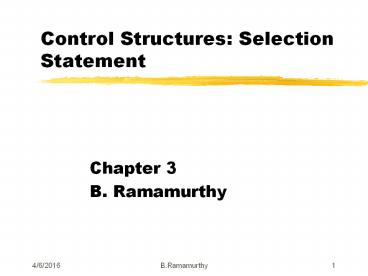Control Structures: Selection Statement - PowerPoint PPT Presentation
Title:
Control Structures: Selection Statement
Description:
A teacher wants to assign letter grade based on percentage points. ... if (rank==1 || rank==2) cout 'Lower division n'; else { if (rank==3 || rank==4) ... – PowerPoint PPT presentation
Number of Views:40
Avg rating:3.0/5.0
Title: Control Structures: Selection Statement
1
Control Structures Selection Statement
- Chapter 3
- B. Ramamurthy
2
Structured Programming
- Sequence
- Selection
- Repetition
yes
no
3
Decision Statements (also known as Selection
Statements)
- How to compare data values?
- Relational operators
- How to alter the sequence of program execution
based on the result? - if.. else statements
- How to deal with multiple choices?
- Switch statement
4
Example
- A teacher wants to assign letter grade based on
percentage points. Percent range and the
corresponding letter grade are as shown in the
table below. Design a C solution (program) for
this problem.
Percent Range gt90 gt80 lt 90 gt70 lt80 gt60 lt70 lt50
Letter Grade A B C D F
5
Relational Operators
- Operator Meaning
- lt Less than ?
- gt Greater than ?
- gt Greater than or equal to?
- lt Less than or equal to?
- Equal to?
- ! Not Equal to ?
- We will use relational operators to form
relational expression of conditions.
6
Logical Operators
- ! not
- and
- or
- These operators are used to combine more than one
condition forming a complex condition.
7
if Statement
- An if statement allows a program to choose
whether or not to execute a following statement. - Syntax (structure/format)
- if (condition)
- statement
- Semantics (meaning)
- condition is a Boolean expression Something
that evaluates to True or False. - If condition is true then execute the
statement.
8
The if statement syntax
- if(expression)
- statement //single statement executed
- //if expression is true
if(expression) //statements inside are
//executed if expression is
true statement1 statement2 statement n
9
If -else Statement
- An if-else statement allows a program to do one
thing if a condition is true and a different
thing if the condition is false. - Syntax
- if ( condition )
- statement1
- else
- statement2
- Statements to be executed for if and else can be
a single statement or multiple statements
enclosed in .
10
The if - else statement syntax
- if(expression)
- statement
- else
- statement
if(expression) statement block
else statement block
11
The switch statement
switch(expression) case
constant statement(s) break case
constant statement(s) break / default
is optional/ default statement(s)
12
The switch statement
- Expression must be of type integer or character
- The keyword case must be followed by a constant
- break statement is required unless you want all
subsequent statements to be executed.
13
Practice!
Convert these nested if/else statements to a
switch statement if (rank1 rank2) cout
ltlt "Lower division \n" else if (rank3
rank4) cout ltlt "Upper division \n"
else if (rank5) cout
ltlt "Graduate student \n" else
cout ltlt "Invalid rank \n"
14
Practice Solution!
switch(rank) case 1 case 2 cout ltlt
"Lower division \n" break case 3 case
4 cout ltlt "Upper division \n" break
case 5 cout ltlt "Graduate student \n"
break default cout ltlt "Invalid rank
\n" //end switch
15
Summary
- In many applications, choices are to be made
depending on some conditions related to the
problem. Selection or decision structures are
used to model such situations. - C supports the implementation of selection
through the if and switch statements. In this
discussion we looked at various forms of
selection statements.































